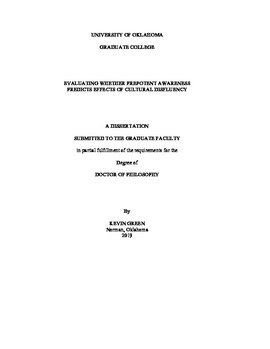| dc.contributor.advisor | Mayeux, Lara | |
| dc.contributor.author | Green, Kevin | |
| dc.date.accessioned | 2020-01-24T19:47:35Z | |
| dc.date.available | 2020-01-24T19:47:35Z | |
| dc.date.issued | 2019-12 | |
| dc.identifier.uri | https://hdl.handle.net/11244/323318 | |
| dc.description.abstract | Two studies assessed whether a single- or dual-prime design could be used to elicit Cultural Disfluency (Aim 1), and whether Prepotent Awareness would predict mean differences computed between Control and Experimental Groups (Aim 2). This mean difference was operationalized as the size of Cultural Disfluency elicited by an incongruence between Prepotent and Emergent Awareness. Use of a Culture-as-Situated-Cognition (CSC) perspective permitted framing Cultural Mindset and Self-Construal as dynamic and interdependent components of Awareness. Two theories provided grounds for hypothesizing whether a Prepotent Awareness characterized by weak or strong Honor endorsement (Study 1) or an Independent or Relational Self-Construal (Study 2) would predict weaker effects of Cultural Disfluency: Action Identification Theory (AIT), and Niche Construction Theory (NCT). Evidence was not found for the efficacy of either the single- or dual-prime design. Evidence was not found for differences in effect sizes of Cultural Disfluency as a function of Prepotent Awareness. | en_US |
| dc.language | en_US | en_US |
| dc.subject | cultural mindset | en_US |
| dc.subject | self-construal | en_US |
| dc.subject | culture | en_US |
| dc.title | Evaluating Whether Prepotent Awareness Predicts Effects of Cultural Disfluency | en_US |
| dc.contributor.committeeMember | Mendoza, Jorge | |
| dc.contributor.committeeMember | Riggs, Wayne | |
| dc.contributor.committeeMember | Gronlund, Scott | |
| dc.date.manuscript | 2019-12 | |
| dc.thesis.degree | Ph.D. | en_US |
| ou.group | College of Arts and Sciences::Department of Psychology | en_US |
| shareok.nativefileaccess | restricted | en_US |
